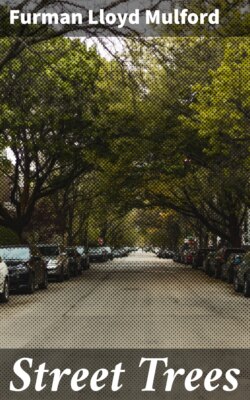Читать книгу Street Trees - Furman Lloyd Mulford - Страница 9
На сайте Литреса книга снята с продажи.
QUALITIES NECESSARY.
ОглавлениеTable of Contents
Compared with the whole number of trees used for ornamental planting, the number of kinds suitable for street planting is very small. For use under city conditions a tree must be adapted to the climate and to the soil upon which it is to be grown. It must have healthy foliage that withstands dust and smoke and a root system not easily affected by unusual soil conditions, by restricted feeding areas, or by root pruning when street improvements are made. The top should be in proportion to the width of the street upon which it is used, and it should be rather high headed or easily trained to that form and of open growth without being too spreading or sprawling.
Of minor consideration is the character of the foliage masses, whether dark or light, heavy and somber or open and airy, and also whether they have vivid autumn colorings. Only in the most southern parts of the country and in western California should evergreen trees be considered for street planting, and then only the broad-leaved evergreens, such as magnolias and live oaks. In the North the lack of sunshine during the short cloudy days of winter makes it desirable to admit all the light possible. Even in the South the question of sunshine should be considered when selecting varieties.
P125365HP
Fig. 14.—Narrow upright trees (Lombardy poplars) on a Barrow Conditions, it is better street. Washington, D. C.; midsummer.
Narrow streets should be planted with columnar trees (fig. 14) or sometimes with small trees. Broad streets may be planted with spreading trees (figs. 3 and 16), or, if provided with a central parking space, with moderate-sized trees in the center and on the sides, or with trees on the sides suited to the space and formal trees in the center. (fig. 15.)
P18856HP
Fig. 15.—Formal trees in a central parking, but appropriate trees wanting on the sides of the street. Canary Island date palms in Merced, Calif.; midsummer.
As a rule, trees native to the locality that have been successfully grown in other cities should be given the preference. When a choice must be made between untried native trees and those tested in a city or town under different soil or climatic to give the native trees the first trial. There are many native trees that are promising which have not been planted on a sufficient scale or under sufficiently varied conditions to demonstrate their real value for street planting over any considerable area. Many of the trees mentioned in this bulletin may prove valuable far beyond the areas for which they are suggested. The burr oak, the swamp white oak, the scarlet oak, the chestnut oak, the white oak, the sour gum, and others may be found on further trial to be as valuable as those already demonstrated to be valuable over large areas. Those mentioned have all been tested in a small way.
Caution should be used in selecting trees with conspicuous flowers and those with edible fruits or nuts, as in many parts of the country such trees are badly mutilated by the public. Even horse-chestnuts, although the nuts are not edible, are often broken by boys clubbing the trees. That public opinion can prevent such vandalism is in evidence all along the Pacific coast and at a few places in the East. Every effort should be made to create a sentiment that will protect these attractive additions to street adornment, but where the sentiment does not exist it is better to avoid the planting of such trees except in a limited way.
P15394HP
Fig. 16.—Live oaks, the handsomest southern street tree for broad street: Biloxi, Miss.; late summer.
Besides the native trees there are many introduced trees that have proved valuable and many more that are worthy of trial.[1] A fair trial of promising introduced trees should be made, and the native kinds should be thoroughly tested.
